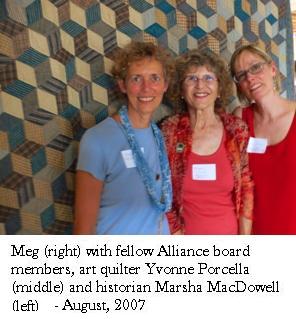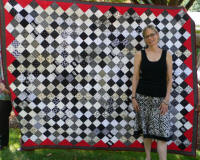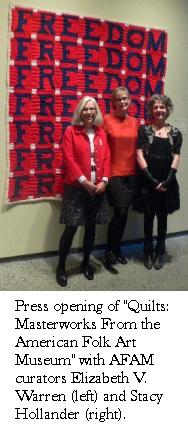1) How do
you prefer to be described as, within the field of textile
history?
"Quilt Journalist.
"I’m an author/journalist who happens to think the current quilt
boom is an absolute barn-burner of a good story. I love to give
quilters a deeper understanding of the amazing state of the
quilt world, and serve as an ambassador to the non-quilting
world via lectures and articles. I think quilting deserves good
journalism: if major media outlets have regular columns on rock
music, poker and wine, why not quilts?"
2) Please tell us about your work or business in the field
today
"My interest in telling the story of quilts brought me to the
nonprofit Alliance for American Quilts, which I currently serve
as president.
"I write regular columns in three quilting publications: The Quilt
Life (Look Who’s Quilting Now, a profile of an unexpected
quilter); Quilter’s Home (a gossip column called The Skinny) and
Fab Shop News (a business column called Trade Talk).
"I also write a free monthly e-newsletter called Quilt Journalist Tells All.
"Most importantly, I’ve become known for my book
The Quilter’s
Catalog: A Comprehensive Resource Guide, published in 2008."
3) When and where did you begin your serious interest in the
history of quilts?
"My mother taught me to quilt (by hand) more than 20 years ago
but I didn’t truly dig into quilting as a topic until I began
reporting my third book, a resource guide for 21st century
quilters. When I began quilting, I worked fulltime as a staff
writer for the Wall Street Journal in NYC, and the only person I
knew who quilted was my mother, in coastal North Carolina.
"I left the Journal in 1994 when my son was born to take up
freelance writing, including two books about family traditions.
While considering what topic to take up next, I decided to go to
the AQS show in Paducah in 2002 for research on the quilt scene.
I was blown away by the size of the industry, the artistry of
the quilts, the high-tech aspect of quilting and the amazing
entrepreneurial vibe. I spent 5 years researching and writing
the 600-page book, The Quilter’s Catalog. It’s been widely
praised both within and beyond the quilt world and has so far
sold more than 60,000 copies."
3) What “known” individual (or group) influenced you most and
why?
"I was very much influenced by the nonprofit Alliance for
American Quilts (AAQ), especially its co-founder Shelly Zegart,
who was one of the first people I interviewed for my book. As a
quilt collector and the founder of the first state quilt
documentation project, in Kentucky in 1981, Shelly really
understood how important it was to save the stories behind
quilts. All these amazing quilts would come pouring out of
attics, bedrooms and garages, and a group of dedicated
volunteers would capture and catalog the stories before the
quilts disappeared back into those hidden places!
"Eventually, many of those state documentation projects would be
archived on the Quilt Index, a database of more than 50,000
quilts jointly run by the Alliance for American Quilts, Michigan
State University’s Museum and MSU’s MATRIX: Center for Human
Arts, Letters and Social Sciences Online. Thankfully Shelly and
her co-founders, including Karey Bresenhan, founder of
International Quilt Festival and a pioneer in quilt
documentation in Texas, decided that the best repository of the
resources they were creating was the web, which was much less of
a tool at the time the Alliance was founded in the early ‘90s.
"Early on in my reporting, Shelly asked me to join the AAQ
board: she liked that I was a quilter but also had an
up-to-the-minute understanding of the major individuals and
companies behind the quilt boom, due to my book research. After
several years of her urging, I joined the board in 2005. Shortly
after that, Shelly decided to launch the Alliance into the world
on its own: stepping back from her long, active years at the
helm, moving the AAQ from her home in Louisville, Ky. to its
current location in Asheville, N.C.. I stayed on the board,
working hard for the organization, writing its newsletter and
other materials, serving as vice president, and in August, 2010,
the Alliance voted me president.
"The organization continues to be a major force and focus in my
work: it’s a uniquely good fit for me because it emphasizes the
stories of quilts and quilters, both past and in the present.
Also, the board echoes the nonprofit’s emphasis on what it means
to have allies, to build an alliance: it brings together
historians, curators and collectors, but also every type of
quiltmaker and representatives of the quilt industry. I get
enormous inspiration from serving on a board that includes
everyone from the CEOs of HandiQuilter and Moda fabrics, to a
25-year-old prize-wining male art quilter.
4) Who became your personal mentor as you began your
learning?
"In some ways, it’s hard to have a mentor as a journalist in
this field, when it comes to the writing itself.
"As far as people who provided guidance as I researched my book,
I would single out Liza Prior Lucy, the quilter and entrepreneur
who co-writes books with Kaffe Fassett and teaches with him as
well. Liza actually got Kaffe, who was a star in the knitting
world, to try quilts. She’s a great networker and cheerleader
and she helped me immensely, contributing everything from
suggesting people for my chapter on the Top Quilt Teachers in
the U.S., to helping me pick fabric for some of the 12 projects
in the book. I still get her advice on a regular basis. She has
her finger on the pulse.
"I also got a lot of mentoring early on from Karen Musgrave, a
real stalwart within the AAQ when I arrived, who conducted
hundreds of the interviews in the Alliance’s oral history
project and has a solid knowledge of contemporary quilting. She
was always available as a sounding board, even if we didn’t
always agree on specific points. (We even had a debate on the
use of the word “quilter” versus “Quiltmaker.”)
"If you ask who inspired and inspires me as a writer, I would
name a number of individuals, including historians Laurel Horton
and Barbara Brackman, who both do good original research and
write in a lively manner. I’m also impressed by the hard work
and passion of Kyra Hicks, who has written a number of books
about African-American quilters and quilt history. Frankly, I
have also been inspired by Mark Lipinski, aka “the bad boy of
quilting,” the irreverent founding editor of Quilter’s Home
magazine. Mark showed that there could be a lifestyle magazine
about quilting, and he showed writing on the topic could be
witty and fun."
5) What aspect of study were you most passionate about at
first? How has this changed over time and why?
"At first, and for a long time, I was most fascinated by all the
different reasons for the continuing quilt renaissance. It
amazed me to think that lots of quilters today make as many
quilts in a year as 19th century women made in a lifetime: that
changes everything. I love to study contemporary quilting within
the context of modern American culture. The coming together of
computers and patchwork has taken modern quilting to such a
diverse, rich, global place.
"As a former reporter for the Wall Street Journal I’m fascinated
by the business aspect of quilting, how many people have made
(or tried to make) a living from quilts in one way or another. I
think even most quilters don’t realize that Eleanor Burns has
more books in print than Martha Stewart!
"Right now, I’m also getting more immersed in the thread of
quilting and other needle arts through the whole arc of
America’s history.
"I'm in front of a quilt I made (right; click to enlarge).
I was interviewed for the Alliance's oral
history project, Quilters' S.O.S. -Save Our Stories,
in Asheville, NC. For each Q.S.O.S. interview, the interviewee brings a "touchstone quilt"
to discuss her or his quilt history. This quilt is my homage to
my 17-year career at the Wall Street Journal and is called
"Black and White and Read All Over." (In my day, there was no
color in the Journal.) I feel compelled to add that it truly was
an accident that my outfit matched the quilt. What can I say? I
love black and white.
"These days, I'm becoming more involved in doing interviews
myself for the AAQ's
oral history project. My recent interviews include Kaffe Fassett,
and Caryl Bryer Fallert, and I’m scheduled to interview
television host Alex Anderson and historian Barbara Brackman."
6) What is your current “Pet project”
"I’m researching a new quilt-related book for Workman that I
can’t talk about yet, but this one is much more a history book
than The Quilter’s Catalog (which included 12 patterns and tons
of practical sidebars as well as recent history). Also. I’ve
been asked by the publisher, Running Press, of my second book to write a
revised/expanded version of The Book of New Family Traditions
(2003).
"My other main project is helping to grow the amazing resources
of the Alliance for American Quilts."
7) What about quilts and quilting as effected by technology
has fascinated you the most and why? How has this influenced
your articles written for magazines today?
"I think what continues to fascinate me is how unlike the
stereotypes modern quilting actually is, so I want to continue
trying to tell that story to the majority of Americans who are
clueless.
"That goes back to my Wall Street Journal roots and loving an
untold story: I sometimes say quilting is “the biggest invisible
cult in America.
"So one area of writing I am trying to pursue is to get the
mainstream media to cover the real state of quilting, including
the tech piece: I recently contacted the head tech editor at the
Wall Street Journal, to write a story about the new mobile phone
app created by the Quilt Index. For 99 cents, people can have a
quilt documented on the Index downloaded to their phone every
day."
8) Within this arena, what would you like to do, but haven’t
done yet?
"There is so much I would like to do!
"More books, more articles, more notice in the mainstream media.
I would especially like to work more in new media, both for my
own work and to get more audio and video and interactive
galleries introduced to the Alliance website. That’s all part of
the organization’s 5-year-plan.
"One of my goals is to get the Alliance’s Q.S.O.S. oral history
project as well known as the Story Corps project, which has a
spot on NPR every Friday."
10) Please describe (in a list) the contributions you have made
via books and articles, presentations, exhibits, contests,
articles, fabric lines, and research papers
Books
The Quilter’s Catalog: A Comprehensive
Resource Guide
(Workman Publishing, 2008)
Book Foreword to Journey of Hope: Quilts Inspired by
President Barack Obama by Carolyn Mazloomi (Voyageur Press,
2010)
Articles - These are in addition to the regular
magazine columns cited at the beginning of the interview.
“Stitching
Up the Future," The Wall Street Journal,
April 12, 2008.
“Stops
Along the Summer Quilt Trail,” The Wall Street Journal. May 23,
2009.
“Quilts
for Obama,” Daily Best news website. May 16, 2009.
“Selling Quilt Books in a Crowded Market,” SAQA Journal, Summer
2009.
“The 26 Most Influential People in Quilting,” Mark Lipinski’s
Quilter’s Home, May/June 2008.
“The Broadway Quilters,” The Quilt Life, December 2010.
“Behind the Scenes at the Museum,” (profile of Elizabeth V.
Warren, a curator at the American Folk Art Museum), The Quilt
Life, February, 2011.
“A Window Into Quilting Opens at the Mall,” Fab Shop News, April
2010.
Lectures and Workshops:
“American Quilts: Then & Now,”
Newark Museum and various historical societies, libraries and
guilds.
“What is a Quilt? And Why You Should Make One”
Lecture presented at the Newark Museum (Newark, NJ) and the
American Folk Art Museum (NYC), among other venues.
"Quilt Journalist Tells All”
Exhibits
I helped the Alliance put together the “If These Quilts
Could Talk” exhibit at Houston’s Quilt Festival in 2010, which
included 14 quilts from the AAQ’s oral history project,
Quilters’ S.O.S. – Save Our Stories. I am very much interested
in helping create future exhibits for the Alliance, both
virtually and in exhibition spaces around the country.
Website:
www.megcox.com
Thank you Meg
for letting us know that it is possible to come from as far on
the other side of the earth as Wall Street to find yourself
quite comfortable and cozy writing about quilts, the women who
make them today and their past history. Cultivating a reporter’s
mind and an education in journalism can go far in documenting
today’s quilters, quilting and technology’s massive impact on
quilting. I look forward to your next book too.